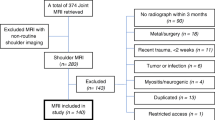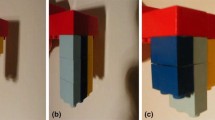Abstract
Objective
To identify the morphological characteristics of the acromion and subacromial bursal space after arthroscopic acromioplasty using magnetic resonance imaging (MRI).
Materials and methods
One hundred patients who received arthroscopic rotator cuff repair and acromioplasty each received at least three MRI examinations (preoperative, first immediate postoperative, and second follow-up imaging between 8 months and 1 year postoperatively). Changes over time in the thickness and morphology of the postoperative acromion as well as the subacromial bursal space were assessed. Clinical and radiological parameters were also analyzed to identify any association with changes in acromial morphology.
Results
Despite minimal acromial thinning observed at the first immediate postoperative state, the acromions showed significant thinning at the second postoperative MRI, with a mean reduction of 32%. Along with acromial thinning, an exaggerated concave contour of the acromial undersurface was observed in some patients. In the subacromial space, a loculated fluid collection developed in 91% of the patients at the second postoperative follow-up. No statistically significant association was noted between postoperative acromial thickness change and clinical or radiological factors (P value > 0.05).
Conclusion
A significant delayed reduction in acromial thickness within approximately 1 year of arthroscopic acromioplasty is thought to be a normal postoperative feature. The simultaneous collection of a loculated, cyst-like fluid in the subacromial bursal space may be an important associated factor of postoperative acromial thinning.




Similar content being viewed by others
References
Rekola KE, Keinanen-Kiukaanniemi S, Takala J. Use of primary health services in sparsely populated country districts by patients with musculoskeletal symptoms: consultations with a physician. J Epidemiol Community Health. 1993;47(2):153–7.
Urwin M, Symmons D, Allison T, Brammah T, Busby H, Roxby M, et al. Estimating the burden of musculoskeletal disorders in the community: the comparative prevalence of symptoms at different anatomical sites, and the relation to social deprivation. Ann Rheum Dis. 1998;57(11):649–55.
Colvin AC, Egorova N, Harrison AK, Moskowitz A, Flatow EL. National trends in rotator cuff repair. J Bone Joint Surg Am. 2012;94(3):227–33.
Hermans J, Luime JJ, Meuffels DE, Reijman M, Simel DL, Bierma-Zeinstra SM. Does this patient with shoulder pain have rotator cuff disease?: the rational clinical examination systematic review. JAMA. 2013;310(8):837–47.
Budoff JE, Nirschl RP, Guidi EJ. Debridement of partial-thickness tears of the rotator cuff without acromioplasty. Long-term follow-up and review of the literature. J Bone Joint Surg Am. 1998;80(5):733–48.
Uhthoff HK, Hammond DI, Sarkar K, Hooper GJ, Papoff WJ. The role of the coracoacromial ligament in the impingement syndrome. A clinical, radiological and histological study. Int Orthop. 1988;12(2):97–104.
Bigliani LU, Levine WN. Subacromial impingement syndrome. J Bone Joint Surg Am. 1997;79(12):1854–68.
Hiemstra LA, Sasyniuk TM, Mohtadi NG, Fick GH. Shoulder strength after open versus arthroscopic stabilization. Am J Sports Med. 2008;36(5):861–7.
Mohtadi NG, Hollinshead RM, Sasyniuk TM, Fletcher JA, Chan DS, Li FX. A randomized clinical trial comparing open to arthroscopic acromioplasty with mini-open rotator cuff repair for full-thickness rotator cuff tears: disease-specific quality of life outcome at an average 2-year follow-up. Am J Sports Med. 2008;36(6):1043–51.
Huijsmans PE, Pritchard MP, Berghs BM, van Rooyen KS, Wallace AL, de Beer JF. Arthroscopic rotator cuff repair with double-row fixation. J Bone Joint Surg Am. 2007;89(6):1248–57.
Pierce JL, Nacey NC, Jones S, Rierson D, Etier B, Brockmeier S, et al. Postoperative shoulder imaging: rotator cuff, labrum, and biceps tendon. Radiographics. 2016;36(6):1648–71.
Beard DJ, Rees JL, Cook JA, Rombach I, Cooper C, Merritt N, et al. Arthroscopic subacromial decompression for subacromial shoulder pain (CSAW): a multicentre, pragmatic, parallel group, placebo-controlled, three-group, randomised surgical trial. Lancet. 2018;391(10118):329–38.
Beltran LS, Bencardino JT, Steinbach LS. Postoperative MRI of the shoulder. J Magn Reson Imaging. 2014;40(6):1280–97.
Sun Z, Fu W, Tang X, Chen G, Li J. Systematic review and meta-analysis on acromioplasty in arthroscopic repair of full-thickness rotator cuff tears. Acta Orthop Belg. 2018;84(1):54–61.
Cheng C, Chen B, Xu H, Zhang Z, Xu W. Efficacy of concomitant acromioplasty in the treatment of rotator cuff tears: a systematic review and meta-analysis. PLoS One. 2018;13(11):e0207306.
Song L, Miao L, Zhang P, Wang WL. Does concomitant acromioplasty facilitate arthroscopic repair of full-thickness rotator cuff tears? A meta-analysis with trial sequential analysis of randomized controlled trials. Springerplus. 2016;5(1):685.
Harryman DT 2nd, Mack LA, Wang KY, Jackins SE, Richardson ML, Matsen FA 3rd. Repairs of the rotator cuff. Correlation of functional results with integrity of the cuff. J Bone Joint Surg Am. 1991;73(7):982–9.
Liu SH, Baker CL. Arthroscopically assisted rotator cuff repair: correlation of functional results with integrity of the cuff. Arthroscopy. 1994;10(1):54–60.
Thomazeau H, Boukobza E, Morcet N, Chaperon J, Langlais F. Prediction of rotator cuff repair results by magnetic resonance imaging. Clin Orthop Relat Res. 1997;344:275–83.
Bishop J, Klepps S, Lo IK, Bird J, Gladstone JN, Flatow EL. Cuff integrity after arthroscopic versus open rotator cuff repair: a prospective study. J Shoulder Elb Surg. 2006;15(3):290–9.
Bigliani LU, Ticker JB, Flatow EL, Soslowsky LJ, Mow VC. Relationship of acromial architecture and diseases of the rotator cuff. Orthopade. 1991;20(5):302–9.
Natsis K, Tsikaras P, Totlis T, Gigis I, Skandalakis P, Appell HJ, et al. Correlation between the four types of acromion and the existence of enthesophytes: a study on 423 dried scapulas and review of the literature. Clin Anat. 2007;20(3):267–72.
Toivonen DA, Tuite MJ, Orwin JF. Acromial structure and tears of the rotator cuff. J Shoulder Elb Surg. 1995;4(5):376–83.
Vanarthos WJ, Monu JU. Type 4 acromion: a new classification. Contemp Orthop. 1995;30(3):227–9.
Cicchetti DV. Guidelines, criteria, and rules of thumb for evaluating normed and standardized assessment instruments in psychology. Psychol Assess. 1994;6(4):284.
Sugaya H, Maeda K, Matsuki K, Moriishi J. Repair integrity and functional outcome after arthroscopic double-row rotator cuff repair. A prospective outcome study. J Bone Joint Surg Am. 2007;89(5):953–60.
Yoshida M, Collin P, Josseaume T, Ladermann A, Goto H, Sugimoto K, et al. Post-operative rotator cuff integrity, based on Sugaya's classification, can reflect abduction muscle strength of the shoulder. Knee Surg Sports Traumatol Arthrosc. 2018;26(1):161–8.
Woertler K. Multimodality imaging of the postoperative shoulder. Eur Radiol. 2007;17(12):3038–55.
Zlatkin MB. MRI of the postoperative shoulder. Skelet Radiol. 2002;31(2):63–80.
Thakkar RS, Thakkar SC, Srikumaran U, McFarland EG, Fayad LM. Complications of rotator cuff surgery-the role of post-operative imaging in patient care. Br J Radiol. 2014;87(1039):20130630.
Jacobson JA, Miller B, Bedi A, Morag Y. Imaging of the postoperative shoulder. Semin Musculoskelet Radiol. 2011;15(4):320–39.
Zanetti M, Jost B, Hodler J, Gerber C. MR imaging after rotator cuff repair: full-thickness defects and bursitis-like subacromial abnormalities in asymptomatic subjects. Skelet Radiol. 2000;29(6):314–9.
Ruzek KA, Bancroft LW, Peterson JJ. Postoperative imaging of the shoulder. Radiol Clin N Am. 2006;44(3):331–41.
Bigliani LU, Cordasco FA, McIlveen SJ, Musso ES. Operative treatment of failed repairs of the rotator cuff. J Bone Joint Surg Am. 1992;74(10):1505–15.
Matthews LS, Blue JM. Arthroscopic subacromial decompression--avoidance of complications and enhancement of results. Instr Course Lect. 1998;47:29–33.
Matthews LS, Burkhead WZ, Gordon S, Racanelli J, Ruland L. Acromial fracture: a complication of arthroscopic subacromial decompression. J Shoulder Elb Surg. 1994;3(4):256–61.
Rupp S, Seil R, Kohn DM. Surgical reconstruction of a stress fracture of the acromion after arthroscopic subacromial decompression in an elite tennis player. Arthroscopy. 1998;14(1):106–8.
Randelli P, Margheritini F, Cabitza P, Dogliotti G, Corsi MM. Release of growth factors after arthroscopic acromioplasty. Knee Surg Sports Traumatol Arthrosc. 2009;17(1):98–101.
Vasara AI, Konttinen YT, Peterson L, Lindahl A, Kiviranta I. Persisting high levels of synovial fluid markers after cartilage repair: a pilot study. Clin Orthop Relat Res. 2009;467(1):267–72.
Galliera E, Randelli P, Dogliotti G, Dozio E, Colombini A, Lombardi G, et al. Matrix metalloproteases MMP-2 and MMP-9: are they early biomarkers of bone remodelling and healing after arthroscopic acromioplasty? Injury. 2010;41(11):1204–7.
Reinhardt RA, Lee HM, Schmid M, Payne JB, Golub L. Relationship between gelatinases and bone turnover in the healing bone defect. J Oral Maxillofac Surg. 2005;63(10):1455–60.
Kenagy RD, Hart CE, Stetler-Stevenson WG, Clowes AW. Primate smooth muscle cell migration from aortic explants is mediated by endogenous platelet-derived growth factor and basic fibroblast growth factor acting through matrix metalloproteinases 2 and 9. Circulation. 1997;96(10):3555–60.
Wilson TJ, Nannuru KC, Singh RK. Cathepsin G-mediated activation of pro-matrix metalloproteinase 9 at the tumor-bone interface promotes transforming growth factor-beta signaling and bone destruction. Mol Cancer Res. 2009;7(8):1224–33.
Author information
Authors and Affiliations
Corresponding author
Ethics declarations
Conflict of interest
The authors declare that they have no conflict of interest.
Additional information
Publisher’s note
Springer Nature remains neutral with regard to jurisdictional claims in published maps and institutional affiliations.
Rights and permissions
About this article
Cite this article
Kang, H.J., Park, J.S., Ryu, K.N. et al. Assessment of postoperative acromial and subacromial morphology after arthroscopic acromioplasty using magnetic resonance imaging. Skeletal Radiol 50, 761–770 (2021). https://doi.org/10.1007/s00256-020-03607-5
Received:
Revised:
Accepted:
Published:
Issue Date:
DOI: https://doi.org/10.1007/s00256-020-03607-5




